The microwave oven market is valued at USD 11.0 billion in 2025 and is projected to reach USD 17.2 billion by 2035, growing at a CAGR of 4.6%. A 5-year growth block analysis offers insight into how the market expands across key periods. From 2021 to 2025, the market is projected to grow from USD 8.8 billion to USD 11.0 billion, passing through incremental values of USD 9.2 billion, USD 9.6 billion, USD 10.0 billion, and USD 10.5 billion. This phase reflects moderate growth, driven by continued demand for energy-efficient and time-saving kitchen appliances, as well as a preference for convenience in cooking.
Consumer adoption increases with innovations in smart microwaves and multi-functional features. Between 2026 and 2030, values rise from USD 11.0 billion to USD 13.8 billion, moving through USD 11.5 billion, USD 12.0 billion, USD 12.6 billion, and USD 13.1 billion. This mid-phase sees an acceleration in market expansion, fueled by technological advancements such as IoT connectivity, touchless controls, and advanced cooking presets. Rising urbanization and a growing focus on modernizing kitchens in emerging economies contribute to this growth. From 2031 to 2035, the market is projected to progress from USD 14.4 billion to USD 17.2 billion, with intermediate values at USD 15.0 billion, USD 15.7 billion, and USD 16.5 billion.
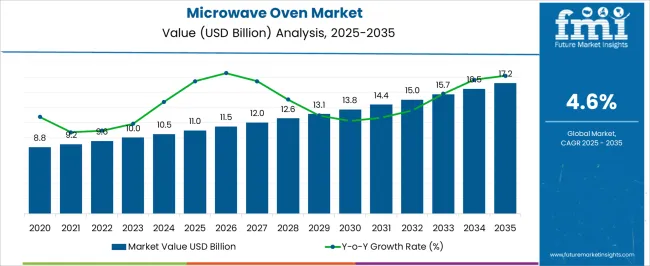
The microwave oven market is driven by five key parent markets that collectively shape its growth, technological advancement, and demand across residential, commercial, and industrial sectors. The home appliances market contributes the largest share, about 30-35%, as microwave ovens are a core product in modern kitchens, offering convenience, time efficiency, and energy-saving benefits for daily cooking and reheating.
The food service and commercial kitchen equipment market adds approximately 20-24%, as microwave ovens are essential in restaurants, cafes, hotels, and other food service establishments for rapid meal preparation, reheating, and quick-service cooking. The electronics and consumer goods market contributes around 15-18%, as microwave ovens are part of the broader category of household electronics. Features such as smart connectivity, touchless controls, and advanced cooking settings increase their appeal. The e-commerce and online retail market accounts for roughly 12-15%, with online shopping platforms boosting the accessibility and convenience of purchasing microwave ovens globally, including niche models and high-end variants.
The energy-efficient appliances market represents about 8-10%, as consumers increasingly prioritize energy-saving features in their microwave ovens to reduce electricity consumption while ensuring optimal performance. Together, these parent markets highlight the multifunctionality, convenience, and technological advancements that drive the growing demand for microwave ovens across various consumer and commercial segments.
| Metric | Value |
|---|---|
| Microwave Oven Market Estimated Value in (2025 E) | USD 11.0 billion |
| Microwave Oven Market Forecast Value in (2035 F) | USD 17.2 billion |
| Forecast CAGR (2025 to 2035) | 4.6% |
The microwave oven market is expanding steadily, driven by changing consumer lifestyles, rapid urbanization, and the growing emphasis on convenience cooking solutions. Industry updates and appliance manufacturing reports have pointed to technological advancements such as inverter-based heating, smart controls, and energy-efficient designs as key factors enhancing consumer adoption.
Rising disposable incomes, coupled with the proliferation of modular kitchens, have further boosted demand across residential and commercial segments. In addition, increasing awareness of healthy cooking methods and the integration of multi-functional cooking capabilities have encouraged consumers to upgrade from basic models to advanced variants.
E-commerce platforms have expanded product accessibility, while promotional campaigns and financing options have supported market penetration in emerging economies. The market’s growth trajectory is expected to remain positive, with leading demand expected from convection microwave ovens for their versatility, countertop models for their affordability and ease of installation, and the 21–25 liters capacity range for its suitability in small to medium households.
The microwave oven market is segmented by product type, structure, capacity, power, price range, end-user, distribution channel, and geographic regions. By product type, microwave oven market is divided into Convection microwave oven, Grill microwave oven, and Solo microwave oven. In terms of structure, microwave oven market is classified into Countertop microwave oven and Built-in microwave oven. Based on capacity, microwave oven market is segmented into 21 - 25 liters, Upto 20 liters, 26 - 30 liters, and Above 30 liters. By power, microwave oven market is segmented into Medium power (700W-1000W), Low power (under 700W), and High power (above 1000W). By price range, microwave oven market is segmented into Medium (USD 50 - USD 100), Low (Under USD 50), and High (Above USD 100). By end-user, microwave oven market is segmented into Residential and Commercial. By distribution channel, microwave oven market is segmented into Offline and Online. Regionally, the microwave oven industry is classified into North America, Latin America, Western Europe, Eastern Europe, Balkan & Baltic Countries, Russia & Belarus, Central Asia, East Asia, South Asia & Pacific, and the Middle East & Africa.
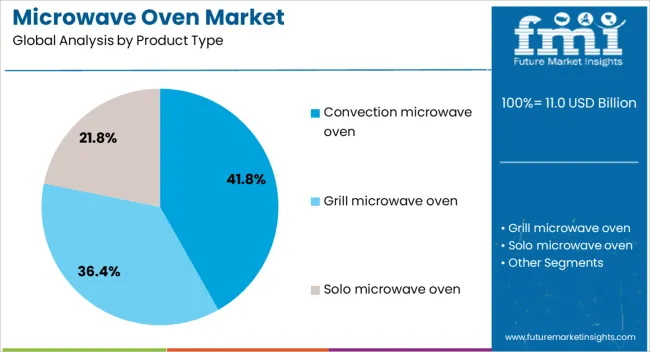
The convection microwave oven segment is projected to account for 41.8% of the microwave oven market revenue in 2025, maintaining a strong position due to its ability to combine microwave heating with convection-based cooking. This dual-function capability allows users to bake, roast, and grill in addition to standard reheating and defrosting, increasing its appeal to consumers seeking versatile cooking appliances.
Manufacturing reports have noted that convection models are increasingly equipped with sensor-based cooking, pre-set menus, and inverter technology for more consistent heating. Growth in home baking and gourmet cooking trends, fueled by social media and cooking shows, has further strengthened demand.
While these ovens typically come at a higher price point compared to solo models, their multi-functionality and time efficiency have justified the investment for many households, ensuring their continued popularity in the market.
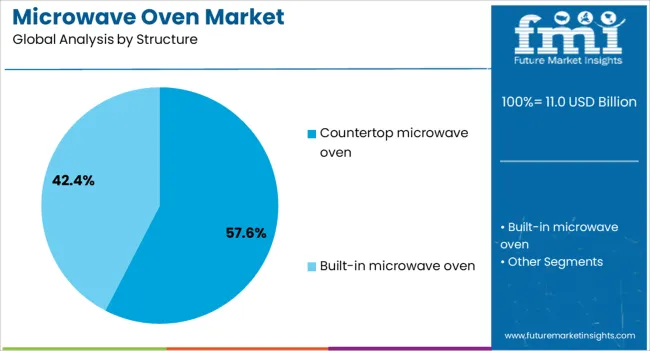
The countertop microwave oven segment is projected to contribute 57.6% of the market revenue in 2025, leading due to its affordability, portability, and ease of installation. Consumers have favored countertop models for their flexibility in placement and suitability for a variety of kitchen layouts without the need for specialized cabinetry.
Retail data has indicated that countertop models dominate sales in both urban and rural markets, with manufacturers offering a wide range of sizes, power levels, and design styles to cater to different consumer needs.
These ovens are also widely available across physical retail stores and online platforms, often accompanied by promotional pricing and bundled offers. The segment’s resilience is further supported by replacement demand from households upgrading older models. As entry-level and mid-range microwave ovens continue to be in high demand, countertop units are expected to sustain their market leadership.
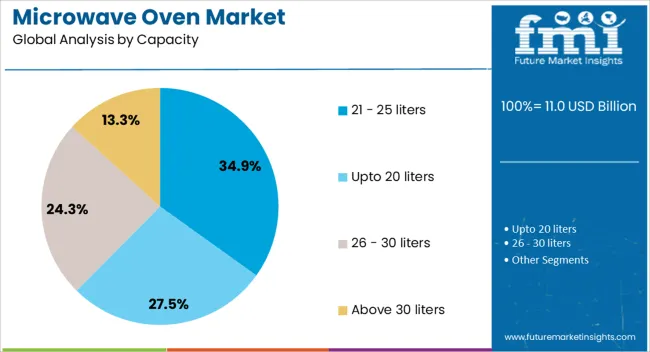
The 21-25 liters capacity segment is projected to hold 34.9% of the microwave oven market revenue in 2025, reflecting its suitability for small to medium-sized households. This capacity range has been widely recognized as optimal for balancing cooking versatility with compact size, making it ideal for apartments and smaller kitchens.
Manufacturers have targeted this segment with models that offer sufficient space for standard cookware while maintaining energy efficiency.
Market trends indicate strong adoption in both single and family households, with consumers appreciating the balance between capacity and counter space requirements. Additionally, appliances in this range often feature user-friendly controls and preset cooking functions, appealing to first-time buyers and those seeking convenience without sacrificing performance. As urban housing continues to favor compact living spaces, the 21–25 liters segment is expected to remain a preferred choice among a broad consumer base.
The microwave oven market is growing due to increasing demand from both residential and commercial sectors for quick, convenient, and energy-efficient cooking solutions. Smart features, multi-functionality, and compact designs are key drivers of market expansion. Challenges include rising competition, technological advancements, and production cost pressures. Opportunities exist in smart microwave ovens, health-focused cooking features, and energy-efficient models. Manufacturers focusing on innovation, user-friendly designs, and IoT integration are well-positioned to capture market share. Asia-Pacific, North America, and Europe remain the key regions, driven by technological adoption, urbanization, and the increasing focus on home automation and energy savings.
In residential settings, the growing trend of busy lifestyles and the need for quick meal preparation are key drivers for microwave adoption. Commercial applications, particularly in restaurants, hotels, and institutional kitchens, are also fueling market growth. Brands such as Samsung, LG, Whirlpool, and Panasonic are leading the market by focusing on product innovation, including multi-functionality, smart features, and compact designs. The demand for energy-efficient, easy-to-use, and multifunctional microwave ovens is expected to continue driving market expansion in the coming years.
Despite strong demand, the microwave oven market faces challenges related to increasing competition, price pressure, and the need for technological advancements. With a large number of global and regional players offering similar products, manufacturers are under constant pressure to innovate while maintaining affordable price points. As consumer preferences shift towards smart appliances, companies are investing heavily in R&D to incorporate features like Wi-Fi connectivity, voice control, and advanced cooking technologies. However, rising material costs and the need for high-quality components to maintain performance and durability can increase production costs, affecting margins. Manufacturers must balance cost-efficiency and innovation to stay competitive.
Opportunities in the microwave oven market lie in the integration of smart features, rising health consciousness, and the growing demand for energy-efficient appliances. The increasing preference for connected homes is driving the adoption of smart microwaves with features like remote control, voice commands, and app-based cooking assistance. As consumers become more health-conscious, there is growing demand for microwave ovens with features that support healthy cooking methods such as steaming, grilling, and air frying. Energy-efficient models are also gaining popularity, as consumers seek ways to reduce their carbon footprint and lower electricity consumption. Companies offering multifunctional, energy-efficient, and smart microwave ovens are well-positioned for future growth.
Technological trends in the microwave oven market include the growing demand for compact designs, multi-functionality, and IoT integration. Space-saving, compact models are becoming increasingly popular in urban homes with smaller kitchens, while multi-functional microwave ovens that combine cooking, grilling, and baking are attracting consumers who seek all-in-one solutions. IoT integration is another emerging trend, with smart microwaves enabling remote control, personalized cooking settings, and real-time updates through smartphones and voice assistants like Alexa and Google Assistant. These innovations are reshaping consumer expectations and pushing manufacturers to continuously upgrade their offerings to stay competitive. Companies that deliver advanced features and improved user experiences are poised to lead in this evolving market.
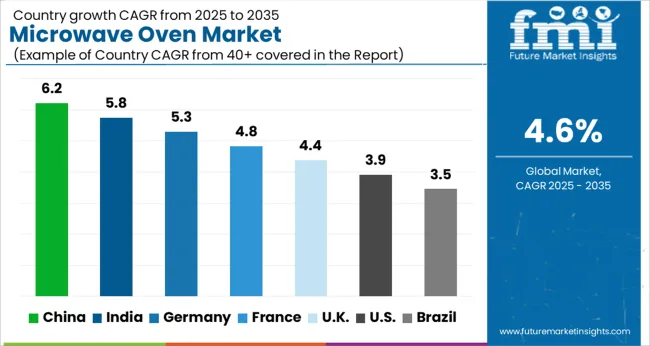
| Country | CAGR |
|---|---|
| China | 6.2% |
| India | 5.8% |
| Germany | 5.3% |
| France | 4.8% |
| UK | 4.4% |
| USA | 3.9% |
| Brazil | 3.5% |
Global microwave oven demand is projected to rise at a 4.6% CAGR from 2025 to 2035. China leads at 6.2%, followed by India at 5.8% and France at 4.8%, while the UK posts 4.4% and the United States records 3.9%. These rates translate to a growth premium of +35% for China, +26% for India, and +11% for France versus the baseline, whereas the UK and United States trail by -4% and -15%, respectively. Divergence reflects local catalysts: urbanization and rising disposable incomes in China, increasing demand for time-saving appliances in India, innovation in smart appliances in France, and more stable demand in mature markets like the UK and USA, where household saturation and slower adoption of premium models contribute to slower growth. The analysis covers 40+ countries, with leading markets outlined below.
The microwave oven market in China is projected to grow at a CAGR of 6.2% from 2025 to 2035. The growth is driven by the increasing urbanization, rising disposable incomes, and an expanding middle class, which has led to a growing demand for home appliances. As more households in China adopt modern kitchen appliances, microwave ovens are becoming essential due to their convenience and speed in food preparation. The rise in small family units and dual-income households also contributes to the demand for time-saving solutions. The growing focus on energy-efficient appliances and the development of smart microwaves with advanced features further propels market growth. Large-scale manufacturing capabilities and the availability of affordable microwave ovens from both local and international brands make the market highly competitive.
The microwave oven market in India is expected to grow at a CAGR of 5.8% from 2025 to 2035. The demand for microwave ovens in India is largely driven by the rising disposable income of the growing middle class and the increasing preference for convenience in cooking. With rapid urbanization, more households are opting for modern kitchen appliances, including microwave ovens, for quicker meal preparation. Microwave ovens are also gaining popularity in smaller cities and towns as people become more aware of their benefits, such as time-saving and energy efficiency. The increase in dual-income households and the rising number of working professionals contribute to the growth of the market. Online retail platforms and promotions are further enhancing accessibility to a wide range of microwave ovens, making them more affordable for consumers.
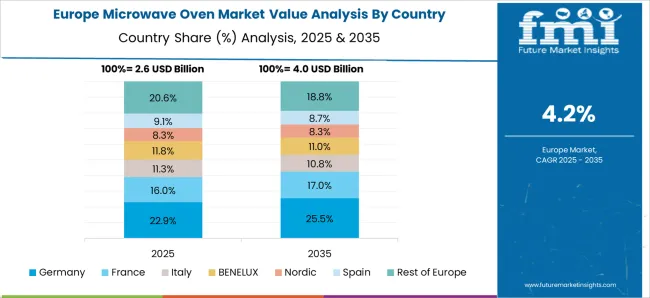
The microwave oven market in France is projected to grow at a CAGR of 4.8% from 2025 to 2035. The demand for microwave ovens in France is driven by consumers’ increasing preference for convenience and energy-efficient cooking solutions. With busy lifestyles and a growing number of working professionals, French consumers are increasingly turning to microwave ovens for quick meal preparation. The popularity of smaller, compact models is on the rise, especially in apartments and smaller living spaces. Furthermore, the demand for advanced features, such as convection cooking and smart technology, is expected to support growth in the premium segment of the market. The strong retail presence, both online and offline, and the increasing availability of innovative products will continue to drive market expansion.
The UK microwave oven market is expected to grow at a CAGR of 4.4% from 2025 to 2035. The demand for microwave ovens is supported by busy lifestyles, increasing urbanization, and the rising number of small households in the country. Microwave ovens are becoming an essential appliance for quick cooking and reheating, particularly among working professionals and students. The trend toward smart home appliances and energy-efficient devices is gaining momentum, with consumers opting for models that offer advanced features like sensor cooking and touch controls. Online retailing and promotions further enhance the accessibility of microwave ovens, making them a popular choice for UK households.
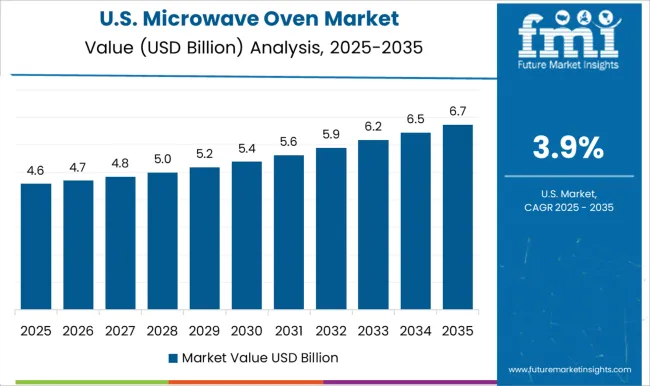
The USA microwave oven market is projected to grow at a CAGR of 3.9% from 2025 to 2035. The USA continues to be a mature market for microwave ovens, with steady demand driven by the convenience factor in cooking. Busy lifestyles, dual-income households, and the popularity of quick and easy meal preparation solutions contribute to the stable demand for microwave ovens. Although growth is slower compared to emerging markets, the focus on energy-efficient, smart appliances and premium features is shaping the market. Moreover, the rise in the popularity of healthy cooking trends and the demand for models with advanced features, such as convection cooking, are expected to sustain market expansion.
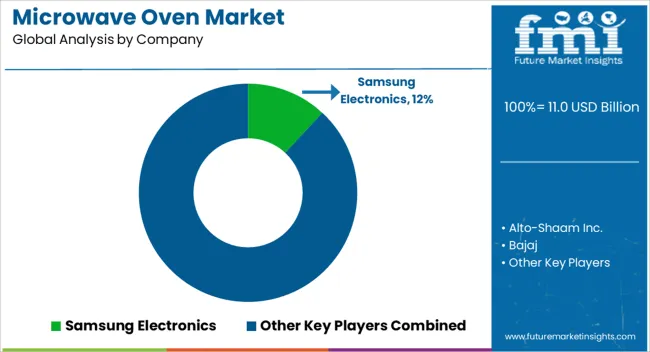
The microwave oven market is highly competitive, with leading players such as Samsung Electronics, Alto-Shaam Inc., Bajaj, Bosch, Breville, Candy, Electrolux AB, Frigidaire, GE Appliances, LG Electronics, Midea Group, Panasonic Corporation, Sharp Corporation, Smeg S.P.A, Toshiba Corporation, and Whirlpool Corporation vying for market share. Samsung Electronics stands out with its innovative designs and smart technology. Its product brochures highlight cutting-edge features like Wi-Fi connectivity, smart sensors, and even cooking modes, targeting consumers looking for convenience and advanced functionality.
LG Electronics focuses on energy-efficient, multifunctional microwave ovens, with brochures showcasing features like EasyClean technology and precise temperature control. Bajaj and Bosch cater to the budget-conscious and mid-range markets, respectively. Bajaj emphasizes affordable yet reliable microwave ovens, highlighting compact designs and ease of use in its brochures. Bosch, on the other hand, focuses on advanced German engineering, offering high-performance models that prioritize durability, efficiency, and sleek design.
Product brochures underscore features like auto-cooking programs, defrosting capabilities, and touch control panels. Breville, Candy, and Electrolux AB offer premium microwave ovens with advanced cooking technologies. Breville’s brochures emphasize superior power and unique cooking functions, like inverter technology for more even cooking. Candy and Electrolux market user-friendly, feature-rich microwave ovens designed for modern kitchens, with an emphasis on space-saving designs and convenience. Frigidaire, GE Appliances, and Whirlpool Corporation dominate with their focus on versatile and durable models that can handle various cooking needs. Their product brochures emphasize user-friendly controls, large capacities, and quick-cooking features. Midea Group, Panasonic, and Sharp Corporation emphasize energy efficiency and versatile features, offering models that can cater to both home and commercial use. Midea and Panasonic’s brochures focus on innovative inverter technology and energy-saving modes, while Sharp showcases its strong brand presence with a focus on ease of cleaning and advanced cooking functions.
| Item | Value |
|---|---|
| Quantitative Units | USD 11.0 Billion |
| Product Type | Convection microwave oven, Grill microwave oven, and Solo microwave oven |
| Structure | Countertop microwave oven and Built-in microwave oven |
| Capacity | 21 - 25 liters, Upto 20 liters, 26 - 30 liters, and Above 30 liters |
| Power | Medium power (700W-1000W), Low power (under 700W), and High power (above 1000W) |
| Price Range | Medium (USD 50 - USD 100), Low (Under USD 50), and High (Above USD 100) |
| End-User | Residential and Commercial |
| Distribution Channel | Offline and Online |
| Regions Covered | North America, Europe, Asia-Pacific, Latin America, Middle East & Africa |
| Country Covered | United States, Canada, Germany, France, United Kingdom, China, Japan, India, Brazil, South Africa |
| Key Companies Profiled | Samsung Electronics, Alto-Shaam Inc., Bajaj, Bosch, Breville, Candy, Electrolux AB, Frigidaire, GE Appliances, LG Electronics, Midea Group, Panasonic Corporation, Sharp Corporation, Smeg S.P.A, Toshiba Corporation, and Whirlpool Corporation |
| Additional Attributes | Dollar sales by product type (countertop, built-in, over-the-range), features (inverter technology, smart connectivity, grill function, convection), and capacity (small, medium, large). Demand is influenced by growing urbanization, the increasing preference for energy-efficient appliances, and the demand for time-saving cooking solutions. Regional trends highlight significant growth in North America, Europe, and Asia-Pacific, driven by the expansion of smart home technology, rising disposable incomes, and increased online retail penetration. |
The global microwave oven market is estimated to be valued at USD 11.0 billion in 2025.
The market size for the microwave oven market is projected to reach USD 17.2 billion by 2035.
The microwave oven market is expected to grow at a 4.6% CAGR between 2025 and 2035.
The key product types in microwave oven market are convection microwave oven, grill microwave oven and solo microwave oven.
In terms of structure, countertop microwave oven segment to command 57.6% share in the microwave oven market in 2025.






Our Research Products

The "Full Research Suite" delivers actionable market intel, deep dives on markets or technologies, so clients act faster, cut risk, and unlock growth.

The Leaderboard benchmarks and ranks top vendors, classifying them as Established Leaders, Leading Challengers, or Disruptors & Challengers.

Locates where complements amplify value and substitutes erode it, forecasting net impact by horizon

We deliver granular, decision-grade intel: market sizing, 5-year forecasts, pricing, adoption, usage, revenue, and operational KPIs—plus competitor tracking, regulation, and value chains—across 60 countries broadly.

Spot the shifts before they hit your P&L. We track inflection points, adoption curves, pricing moves, and ecosystem plays to show where demand is heading, why it is changing, and what to do next across high-growth markets and disruptive tech

Real-time reads of user behavior. We track shifting priorities, perceptions of today’s and next-gen services, and provider experience, then pace how fast tech moves from trial to adoption, blending buyer, consumer, and channel inputs with social signals (#WhySwitch, #UX).

Partner with our analyst team to build a custom report designed around your business priorities. From analysing market trends to assessing competitors or crafting bespoke datasets, we tailor insights to your needs.
Supplier Intelligence
Discovery & Profiling
Capacity & Footprint
Performance & Risk
Compliance & Governance
Commercial Readiness
Who Supplies Whom
Scorecards & Shortlists
Playbooks & Docs
Category Intelligence
Definition & Scope
Demand & Use Cases
Cost Drivers
Market Structure
Supply Chain Map
Trade & Policy
Operating Norms
Deliverables
Buyer Intelligence
Account Basics
Spend & Scope
Procurement Model
Vendor Requirements
Terms & Policies
Entry Strategy
Pain Points & Triggers
Outputs
Pricing Analysis
Benchmarks
Trends
Should-Cost
Indexation
Landed Cost
Commercial Terms
Deliverables
Brand Analysis
Positioning & Value Prop
Share & Presence
Customer Evidence
Go-to-Market
Digital & Reputation
Compliance & Trust
KPIs & Gaps
Outputs
Full Research Suite comprises of:
Market outlook & trends analysis
Interviews & case studies
Strategic recommendations
Vendor profiles & capabilities analysis
5-year forecasts
8 regions and 60+ country-level data splits
Market segment data splits
12 months of continuous data updates
DELIVERED AS:
PDF EXCEL ONLINE
Commercial Microwave Ovens Market Analysis – Size, Share, and Forecast 2025 to 2035
Microwave Source Market Size and Share Forecast Outlook 2025 to 2035
Microwave Monolithic Integrated Circuits Market Size and Share Forecast Outlook 2025 to 2035
Microwave Cable Assemblies Market Size and Share Forecast Outlook 2025 to 2035
Microwaveable Stuffed Animal Toys Market Size and Share Forecast Outlook 2025 to 2035
Microwave Ablation Devices Market Size and Share Forecast Outlook 2025 to 2035
Microwave Market Size and Share Forecast Outlook 2025 to 2035
Microwave Backhaul System Market Size and Share Forecast Outlook 2025 to 2035
Microwave Device Market Size and Share Forecast Outlook 2025 to 2035
Microwave-Safe Utensils Market Size and Share Forecast Outlook 2025 to 2035
Microwave Absorbing Material Market Size, Growth, and Forecast 2025 to 2035
Microwave Power Meter Market
Microwave Antenna Market
High-Power Microwave Source Market Size and Share Forecast Outlook 2025 to 2035
Commercial Microwaves Market
Solid-State Microwave Source Market Size and Share Forecast Outlook 2025 to 2035
Point-to-point Microwave Antenna Market Analysis by Polarization, Antenna Type, Diameter, Frequency Range and Region Through 2035
WiMAX (Worldwide Interoperability For Microwave Access) Market Size and Share Forecast Outlook 2025 to 2035
Oven Bag Market Forecast and Outlook 2025 to 2035
Competitive Landscape of Oven Bag Providers

Thank you!
You will receive an email from our Business Development Manager. Please be sure to check your SPAM/JUNK folder too.
Chat With
MaRIA